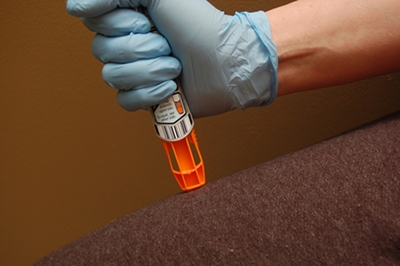Allergy Blog
How to Recognise and Treat Anaphylaxis
The BBC Two show Trust Me, I’m A Doctor recently featured a segment on allergies and anaphylaxis! The segment shows what to do if you encounter someone with anaphylaxis. So what should you do?
Allergies and anaphylaxis are on the increase. A study by Bausch and Lomb shows a 6-fold increase in the past 20 years of the number of people in the UK who suffer from anaphylaxis. Almost 1 in 50 people in the US are affected too. The age group most at risk of fatal anaphylaxis are 17 – 27 year olds.
The most common allergens are food allergens such as peanuts, tree nuts, dairy, eggs, fish and shellfish and also insect stings, latex and medications such as penicillin. Exposure to even a small amount of these allergens can cause a massive reaction in the body known as anaphylaxis.
Symptoms
Symptoms of anaphylaxis can start within minutes of exposure. This is especially true for allergens that are directly introduced into the bloodstream like insect stings and medications.
The symptoms of anaphylaxis can be remembered by thinking of A, B, C. This stands for:
- Airway: swelling of the mouth and throat, hoarseness and difficulty swallowing.
- Breathing: Difficulty breathing, wheezing, rapid breaths, asthma attack.
- Circulation: Pale complexion, clammy, rapid pulse.
Other symptoms to look out for are feeling faint, dizzy or drowsy, pain, nausea and vomiting, itchy, red patches on skin and hives.
Treatment
If the person has been diagnosed with a severe allergy, they may have been prescribed a special auto injector pen that contains a drug called adrenaline. There are different names for these pens depending on the company that makes them. The most common is EpiPen, so EpiPen is often used as a general term to refer to all adrenaline pens. Early injection of adrenaline has been proven to be the best way to treat anaphylaxis.
To administer the drug, make sure the person is sitting or lying down, read the instructions on the pen carefully, make sure you inject on the outside of the thigh about two thirds of the way down. Hold the pen in place for 10 seconds to make sure the full dose has been administered, then massage the site for a further 10 seconds to help it to be absorbed. (The length of time to hold the pen in place against your leg for EpiPen auto-injectors is changing at the moment. Some pens may still be 10 seconds, others have switched to 3 seconds, 5 seconds or several seconds depending on your location. Please check your pen and follow the instructions shown there.)
Always call for an ambulance after administering the adrenaline. In 1 in 12 cases, the symptoms return after 5 or 6 hours even without re-exposure to the allergen, so it is important to get them to a hospital as soon as possible.
If the person does not have an adrenaline pen, make sure to keep them calm, lie them down and elevate their legs. If they lose consciousness, then put them in the recovery position. Call an ambulance as soon as possible!
What to do if you suffer from anaphylaxis
The most important thing to do is make sure you carry your adrenaline pen at all times. This can be difficult for children and teenagers. It can be hard to remember to bring it everywhere and also because children don’t want to be seen as being different from their peers. Having a protective EpiPen case is the best way to make sure they carry their pens always. These cases can be clipped to bags or worn as backpacks to normalise them for children.
Make sure you know how to recognise the symptoms of anaphylaxis and how to administer the pen. Again this can be more difficult for children who may not understand the seriousness of their illness. It is important that if they do begin to feel ill, they don’t go off alone. A good way to make sure everyone can recognise the symptoms and know how to use the adrenaline pen is to have the instructions in the EpiPen case. They are close at hand if needed and the child knows where to get the information and the pen in case of emergency.
Another thing you can do to make living with severe allergies safer is to wear a medical ID bracelet or necklace. This makes it easy for someone to identify the problem if you become ill amongst strangers.
For more information on allergies and anaphylaxis, check out our useful links page.
Image credit: ©Flickr/ Greg Friese
Disclaimer: The information provided is for informational purposes only and is not intended to be a substitute for professional medical advice, diagnosis or treatment. Allergy Lifestyle Limited (t/a) Allergy Lifestyle) uses reasonable endeavours to check the accuracy of information provided however no warranty is given that they are error-free.








